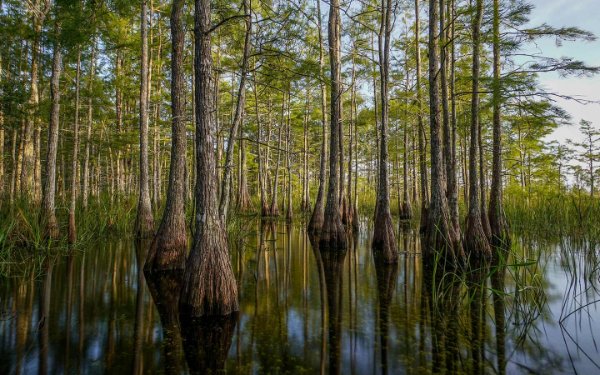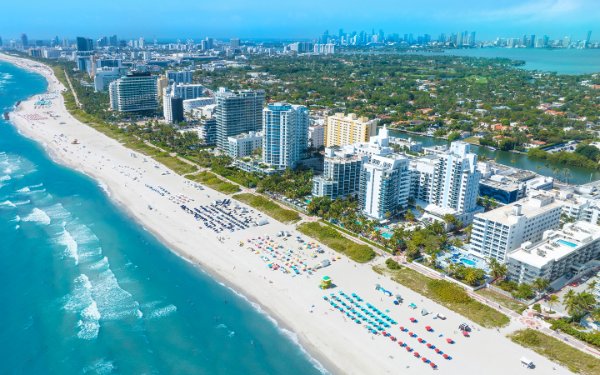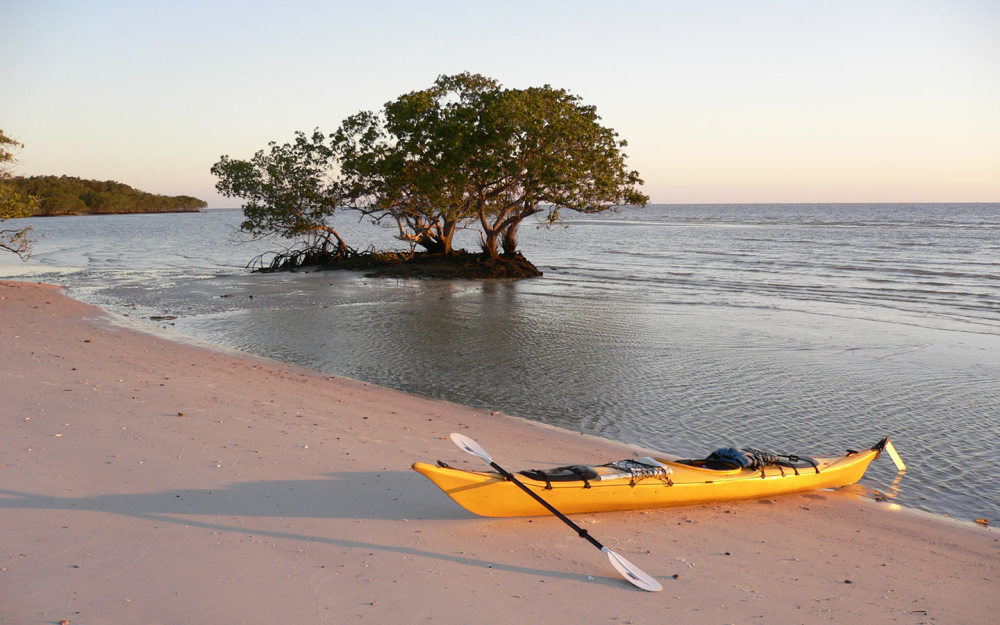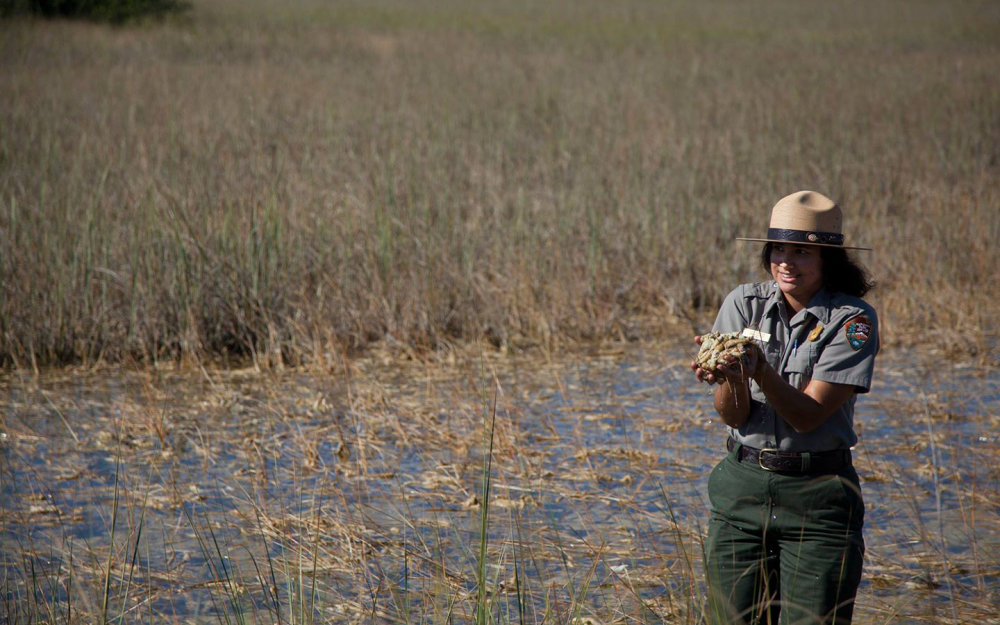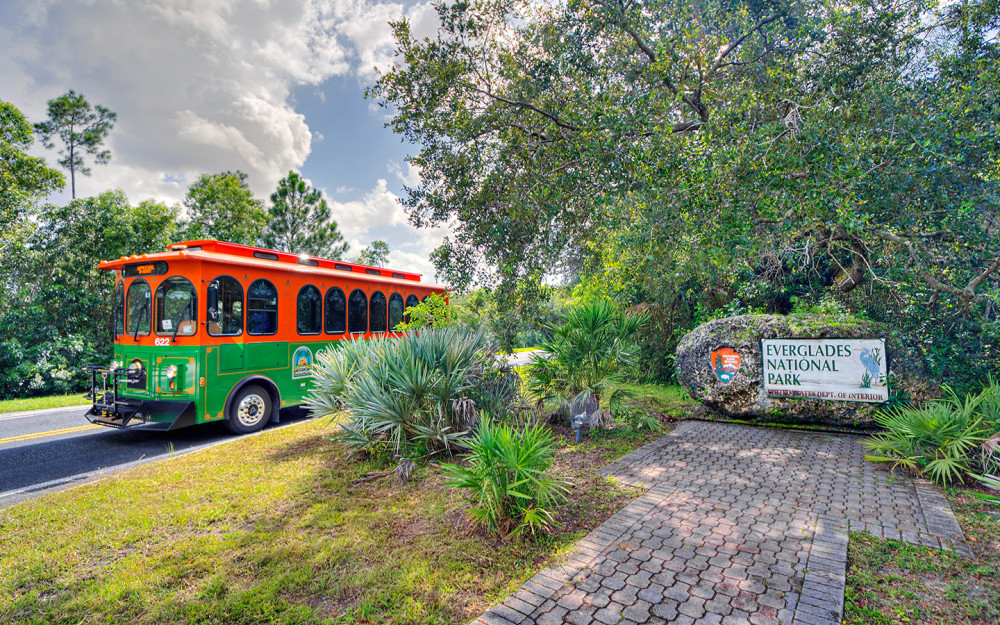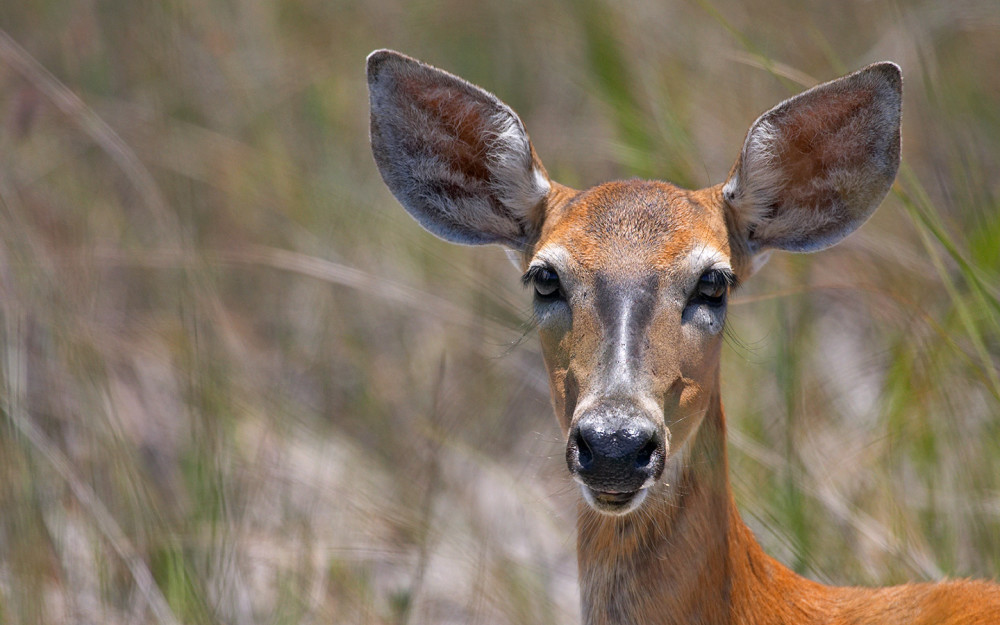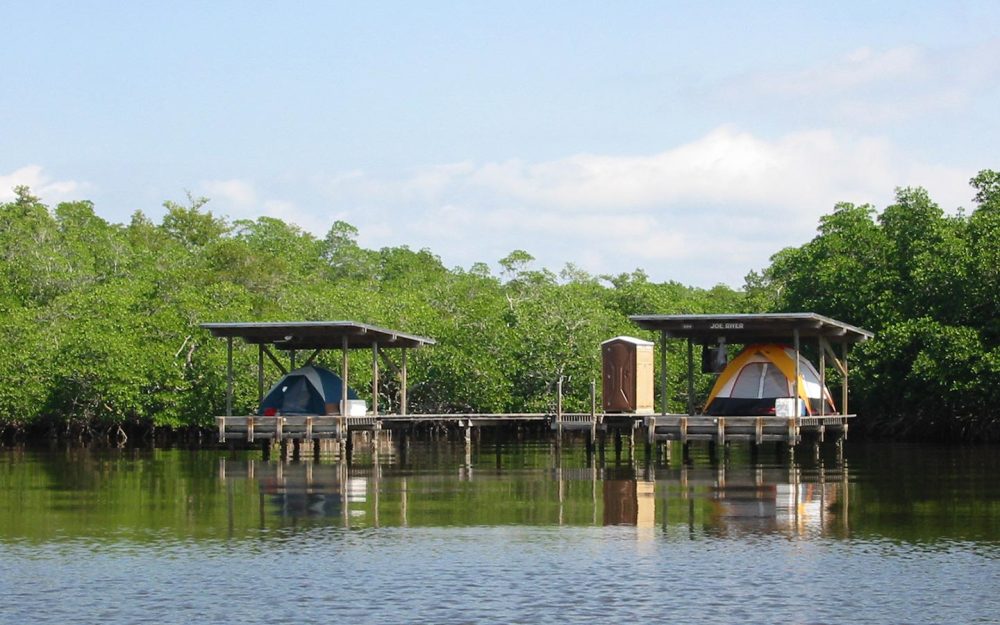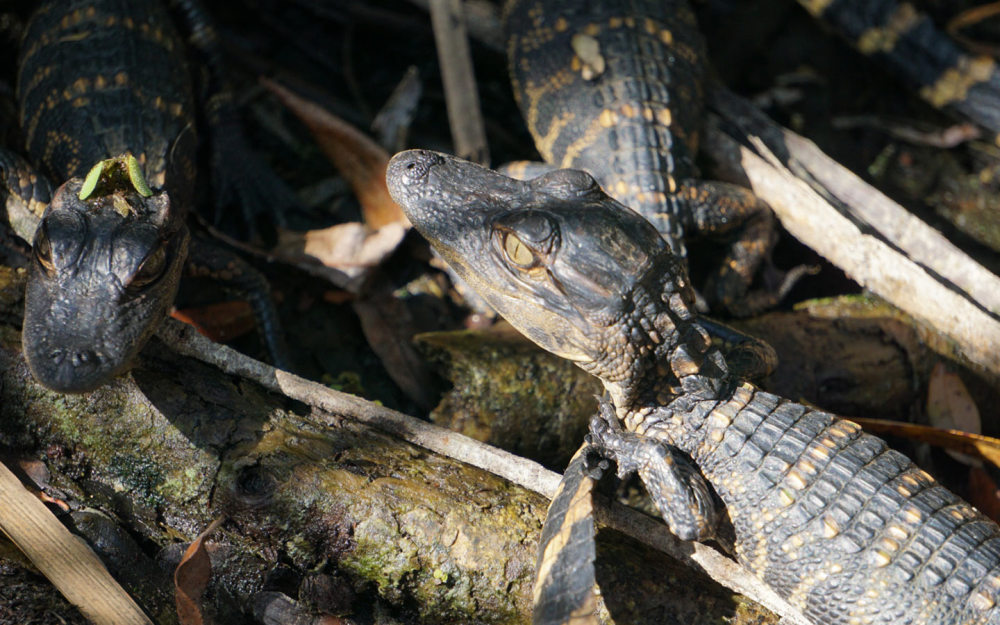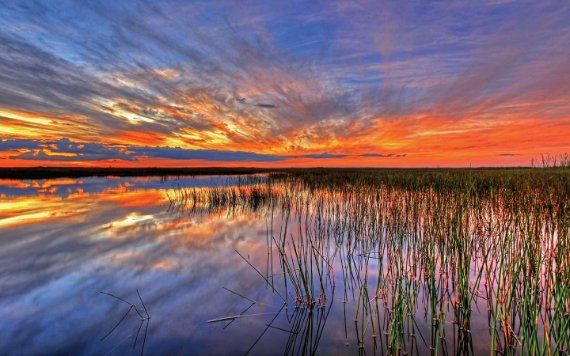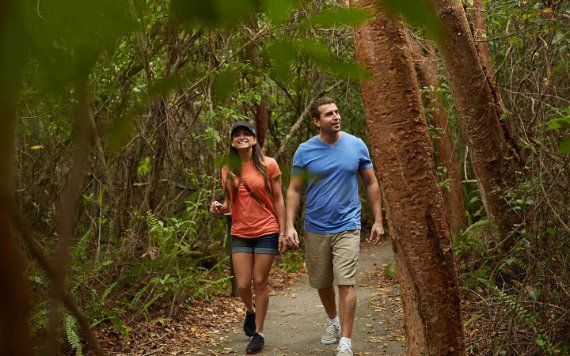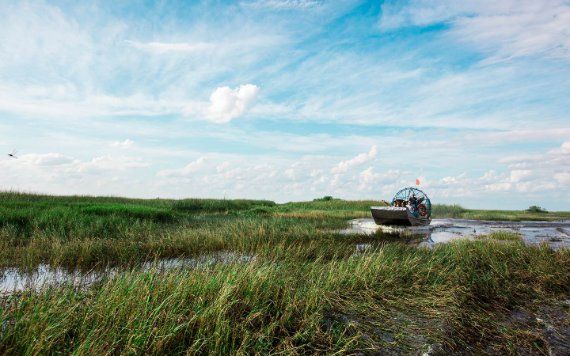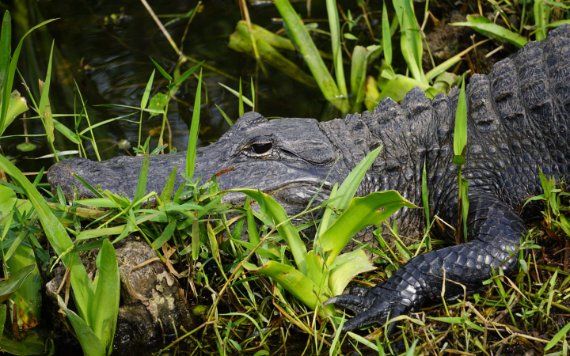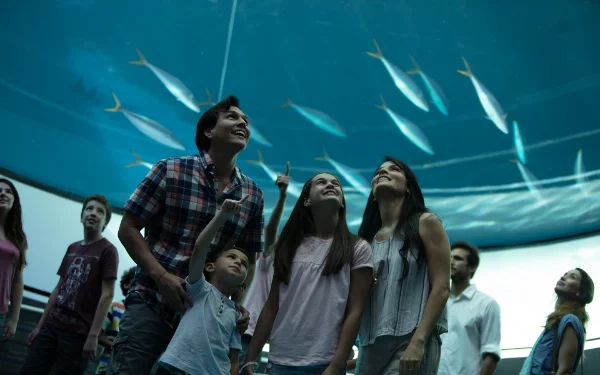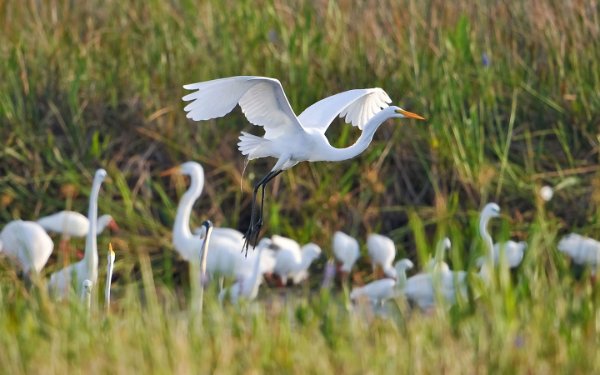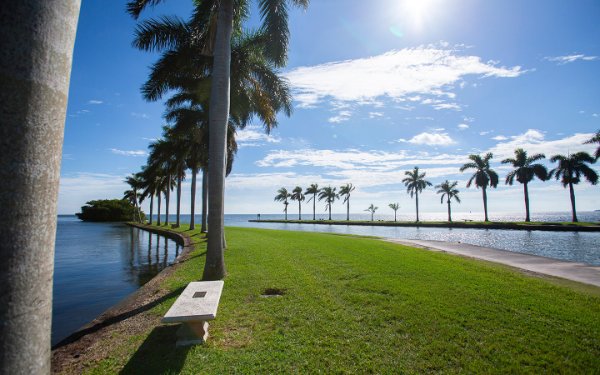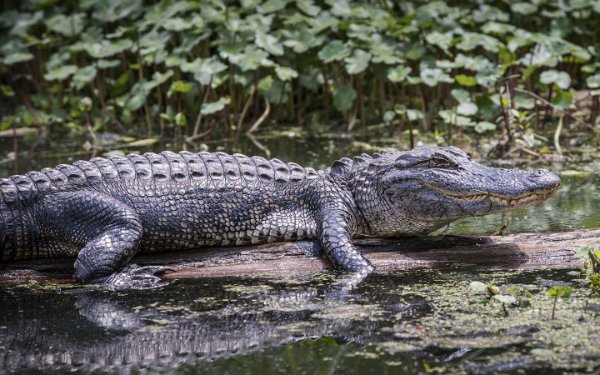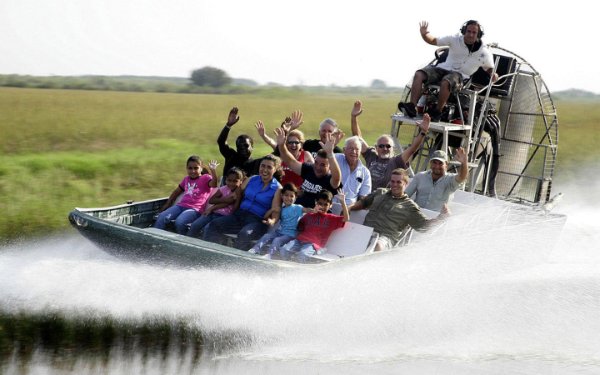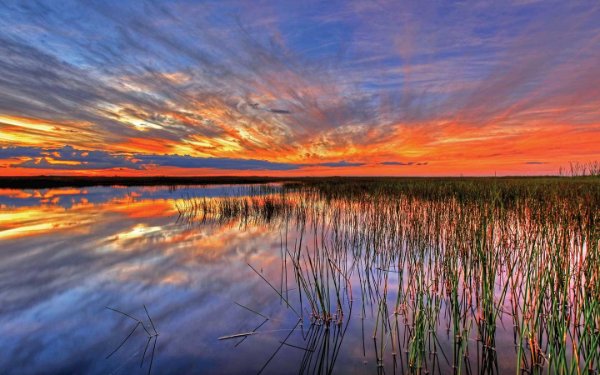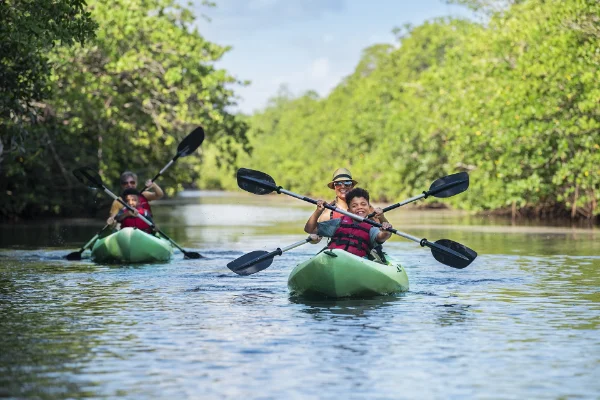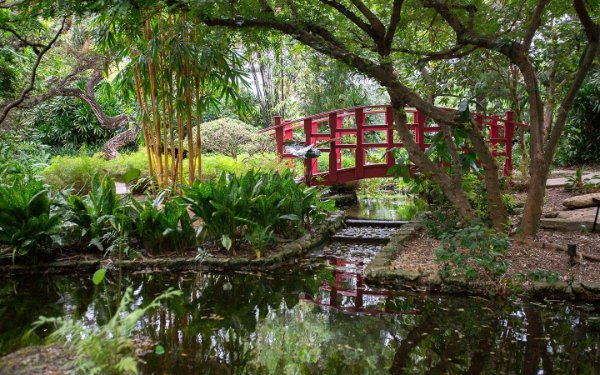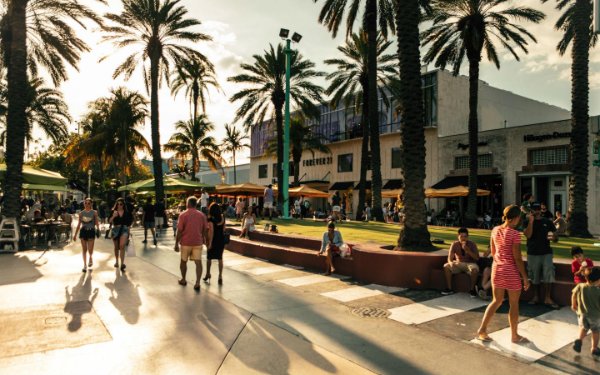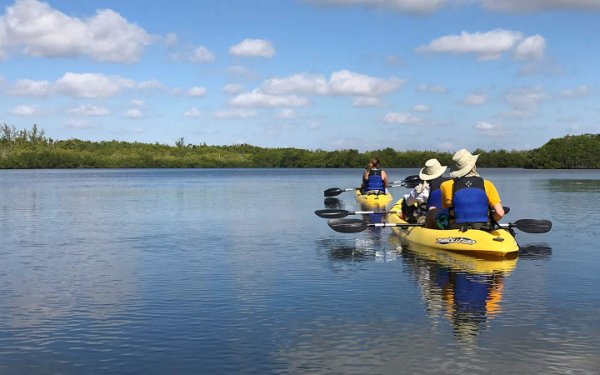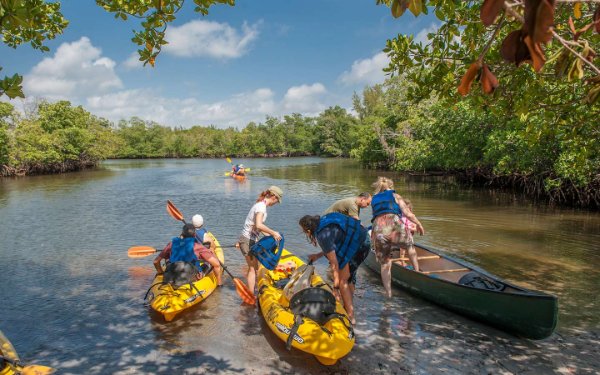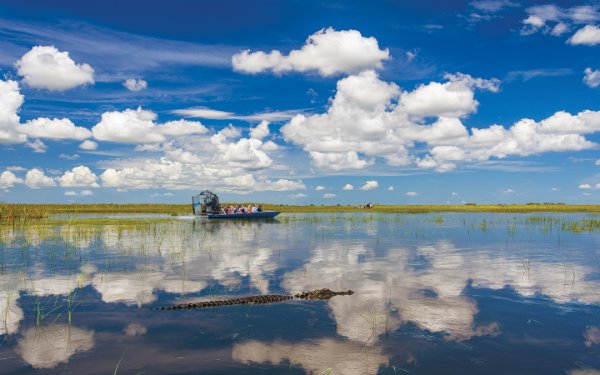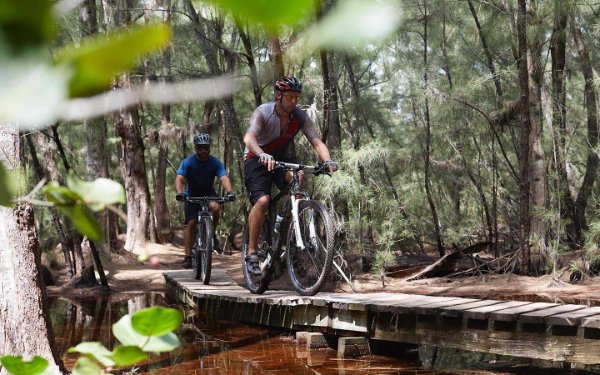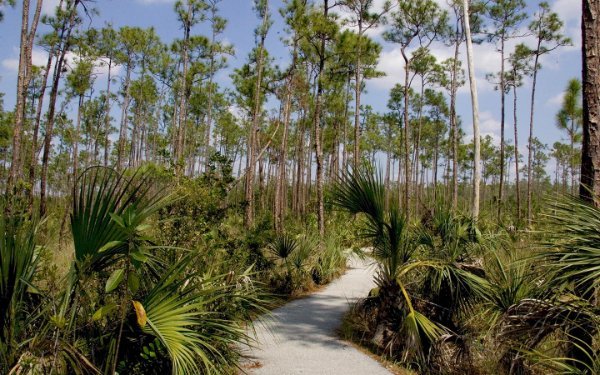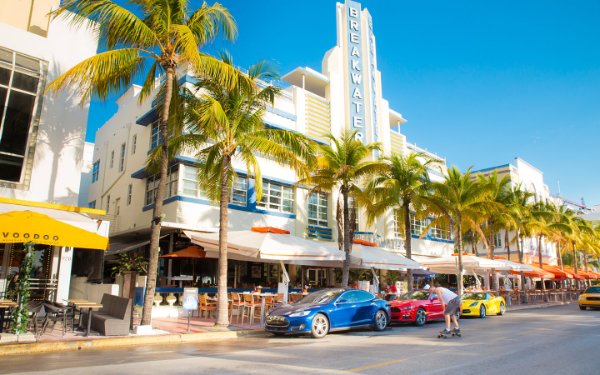
Everglades National Park
Outdoor Experiences
Located at the southernmost tip of the Florida mainland, just before the Florida Keys, Everglades National Park is the largest subtropical wilderness in the U.S. and a UNESCO World Heritage Site. The park’s 1.5 million acres are a mosaic of ecosystems, from slow-flowing freshwater sloughs and salt-tolerant mangrove forests to tropical hardwood hammocks, pine rocklands, freshwater marl prairies, moss-draped cypress domes and the sparkling marine waters of Florida Bay. In these complex systems, you’ll find a wide range of native water and land animals, including alligators basking right off the Anhinga Trail, herons and egrets feasting in the marshes and slow-moving manatees cruising the bay.
Guided Everglades Tours
Ranger-led tours are a good way to get a sampling of what the Everglades has to offer. During the dry season (December-April), ranger-led tours run the gamut from guided hikes and bike rides to canoe trips and even an adventure car caravan. For an immersive swamp experience, try the slough slogging tour, also known as swamp-walking.
Want to get a taste of the extraordinary backcountry but not comfortable paddling a canoe? Consider booking a naturalist-led boat tour of Whitewater Bay, available through the park’s authorized outfitter, Everglades Guest Services. All daily boat tours depart from the Flamingo marina.
If you want to follow a naturalist-led tour from the comfort of your own car, sign up for “Everglades Experience: Guided Tour of Royal Palm, Nike Missile Site, Pa-hay-okee and More.” On this half-day experience, you’ll get to explore some of the park’s most exciting sites. At each stop, you can get out of your car to explore and hear from the guide. Be sure to sign up for a spot in advance. Each tour is limited to three vehicles.
Guided tour options are plentiful at Shark Valley. For starters, embark on a guided tram tour provided by the park’s tour concession, Shark Valley Tram Tours. Led by expert naturalists, you’ll see Shark Valley’s wild residents and learn about the history, fauna and flora of the park. The tour also includes a stop at the park’s observation tower, where you’ll have the opportunity to stretch your legs and take in panoramic views of the Shark River Slough. Reserve a spot on the online calendar.
During the dry season, time your visit to join one of the park’s ranger-led adventures. From swamp-walking through Shark River Slough and a full-moon bike ride to an excursion to witness a meteor shower over the sawgrass prairie, the ranger-led tours offer a chance to gain new insight into the park’s natural beauty.
Explore the Everglades by Bike
Discovering the Everglades by bike gives you the chance to pause for wildlife whenever you choose. If you don’t plan to bring a bike, it’s easy to rent one at the visitors center. Keep in mind that bike rentals are on a first-come, first-served basis, and the bikes can only be used on Tram Road.
Bringing your own knobby tire bike or mountain bike? Consider riding directly into Shark River Slough on the park’s raised L-67 Canal Road – a rugged levee road located off Tamiami Road and 5 miles east of the main Shark Valley visitor area. While you’re there, keep your eyes peeled for all sorts of reptiles such as alligators, snakes and turtles. During the dry season, it’s a prime birding spot too.
Pedal your way through 14 round-trip miles of rugged pine rocklands at Long Pine Key or catch sight of woodland birds as you ride through a tropical hardwood hammock on the 5.2-mile-long Rowdy Bend Trail. Starting at the main road, the 3.2-mile round-trip Snake Bight Trail crosses diverse stands of hardwood hammocks and mangroves, all bustling with wildlife. The difficulty level is easy on the park’s three natural terrain bike trails. If you’re visiting during the start of the dry season, call the Flamingo Visitors Center for updates on trail water levels.
Bike rentals are available at both the Ernest F. Coe Visitors Center and Flamingo Visitors Center. You can book bikes ahead of time on the park outfitter’s website.
Hiking in the Everglades
Planning to explore the Everglades on foot? There are trail options to suit a variety of experience and adventure levels. Whether you’re planning a day hike or a laid-back stroll, the park offers trails that range from less than a quarter mile to 22 miles round-trip, including the 15-mile Tram Road.
Bobcat Boardwalk and Otter Cave Hammock Trail are at the shorter end of the spectrum, offering half-mile and 1-mile trails through sawgrass slough and tropical hardwood hammocks. For a quick and easy wildlife-viewing jaunt, the Anhinga Trail, at just under a mile, is the most popular for seeing Everglades fauna up close, especially alligators.
Ready for a more challenging hike? Cross through coastal prairies of succulents and buttonwood hammocks on the 15-mile round-trip Coastal Prairie Trail to Florida Bay. Although you won’t have to bushwhack your way through it, some parts of the trail may be overgrown and should be traversed carefully.
Airboat Excursions
The airboat is a quintessential Everglades mode of transportation, allowing visitors to skim over the “River of Grass” in a boat powered by a massive fan. Within Everglades National Park, a designated area in Shark River Slough is open to airboat tours conducted by Coopertown, Everglades Safari Park and Gator Park. Coming from Miami, you’ll find all three airboat tour services on Tamiami Trail. Book an airboat tour from any of them for a memorable excursion into the park.
For more details on the ins and outs of exploring Shark Valley, head over to our in-depth Shark Valley guide.
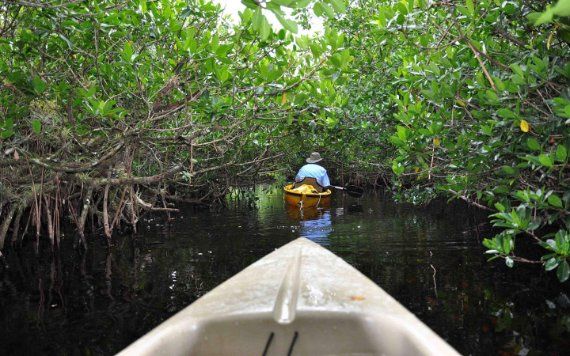
Canoeing and Kayaking in the Everglades
With an abundance of freshwater marshes, mangrove-fringed waterways, creeks and bay waters, Everglades National Park offers some of the best canoeing and kayaking opportunities in Florida. Backcountry waterways abound throughout the park but there are only two marked paddling trails: Nine Mile Pond and Hells Bay.
For a day trip, Nine Mile Pond loop is an ideal beginner-level trail offering a 3- or 5-mile loop. Starting from an easily accessible main park road launch, the trail guides paddlers through a unique area of the park where you’ll find mangroves growing in the freshwater. The trail is a popular place to spot alligators, as well as roseate spoonbills, white-crowned pigeons and wading birds.
Paddle the 11-mile round-trip Hells Bay trail for an immersive experience in a mangrove ecosystem with plenty of twists and turns along the way. Planning an overnight canoe trip? Although the Hells Bay trail can be paddled as a day trip, you also have the option to stay overnight in one of the trail’s three chickees (raised huts).
Don’t have a canoe or kayak? No worries – the park’s outfitter offers rentals at the Flamingo marina dock.
For a serious backcountry excursion, check out the Wilderness Waterway, a 99-mile route that connects Flamingo to Everglades City on Florida’s west coast and offers the opportunity to embark on the canoe trip of a lifetime. Most explorers allow eight days to complete the trip. It’s recommended for experienced paddlers only.
Spotting Florida's Alligators
The Everglades is home to more than 200,000 Florida alligators, a keystone species of the park. The top three places to spot alligators in Everglades National Park are just off the Anhinga Trail; in Shark Valley, just 25 miles west of the Florida Turnpike; and along the Nine Mile Pond paddle loop.
When to Visit Everglades National Park
Everglades National Park is an unforgettable destination year-round. Visiting during the dry season (December-April) is prime time to enjoy everything it has to offer. Mosquito numbers are lower, temps are milder and daily rainfall has largely ceased. As water levels decline, creatures big and small gravitate to the remaining bodies of water, making them easier to find. The dry season is the busiest time for visitors, so advance reservations for tours and campsites are recommended.
Visiting the Everglades during the wet season (May-November) allows you to witness the park in its most lush and verdant state. This period is a great time to go boating as well. Be prepared with insect repellent due to an increased number of mosquitoes, no-see-ums and biting flies during this time. Adequate gear and advance preparation are recommended to make the most of your visit.
Everglades Geography
Spanning three counties – Dade, Monroe and Collier – Everglades National Park has three entrances, including two that are close to the Greater Miami Area: Shark Valley and Homestead (southern region).
Located approximately 40 miles from Downtown Miami off Tamiami Trail, Shark Valley is not only the northernmost entry point into Everglades National Park but also a great option for first-timers who want to get a taste of the Everglades. When you arrive, stop at the Shark Valley Visitor Center for bike rentals, guided tour booking, general information, restrooms and, of course, park rangers’ expert advice.
Getting around Shark Valley is pretty straightforward. Its main, 15-mile paved trail, Tram Road, is where most of the wildlife-viewing, tours, biking and hiking happens. If seeing an alligator is at the top of your list, you can count on plenty of opportunities along the trail. More into birds? Bird lovers can look forward to spotting anhingas, wood storks and other wading birds.
Camping in the Everglades
Fully immerse yourself in the wilds of the Everglades by spending a memorable night (or more) under the stars at one of the park’s scenic campsites. The park offers a variety of camping options, from decked-out eco-tent glamping to primitive, open-air chickees. There are even fully equipped houseboats available for rent. Aside from backcountry camping, all campsites and accommodations are booked via Flamingo Adventures, the park’s outfitter.
Long Pine Key Campground
Nestled in a pine rockland glade about 5 miles from the Ernest F. Coe Visitor Center, Long Pine Key Campground provides an easy overnight nature escape as well as convenient access to miles of hiking and biking trails. Campers can take their pick from 108 sites, which accommodate everything from tents to full-size RVs.
Flamingo Campground
Farther south and situated on Biscayne Bay is Flamingo Campground, which features three camping areas with tent sites as well as spots for RVs in a range of sizes. For a car-free setting and a view of the bay, the Bayside campground has 68 sites located just a short walk from the parking lot.
Both Long Pine Key and Flamingo feature full restroom and shower facilities.
Glamping and Houseboats at Flamingo Campground
Looking for something less rustic than a standard tent? Consider booking a spacious eco-tent complete with a raised deck floor, full or queen size bed and electricity. For a memorable overnight stay on the water, opt for one of the four houseboats equipped with all the necessary comforts including galley kitchen, air-conditioning and bathroom with shower.
Backcountry Camping
Consider yourself a seasoned adventurer? Whether you’re planning a multi-day canoe trip on the Wilderness Waterway, kayaking around Cape Sable or paddling into the backcountry waterways off Whitewater Bay, visitors will find no shortage of primitive campsites and chickees to camp at for the night. A wilderness permit is required for overnight trips into the backcountry so plan to stop at Flamingo to pick one up. To help you plan your trip, a map of backcountry campsites can be found on the park’s website.
Everglades Visitor Information
Everglades National Park is open seven days a week, 24 hours a day. Park staff at the Ernest F. Coe Visitors Center are available between the hours of 9 a.m. to 5 p.m. from mid-April to mid-December and 8 a.m. to 5 p.m. from mid-December to mid-April. At Flamingo, park staff hours are 8 a.m. to 4:30 p.m. from mid-November to mid-April and intermittent during the wet season. If you need to self-register for a backcountry permit, the Flamingo Visitor Center lobby area is accessible 24 hours a day.
Exploring Everglades National Park
Located at the southernmost tip of Florida before you reach the Florida Keys, Everglades National Park is the largest subtropical wilderness in the US and a UNESCO World Heritage Site. The park’s 1.5 million acres encompass a mosaic of ecosystems comprised of slow-flowing freshwater sloughs, salt-tolerant mangrove forests, tropical hardwood hammocks, critically imperiled pine rocklands, freshwater marl prairies, moss-draped cypress domes and the estuarine and marine waters of Florida Bay. In this complex mosaic, you’ll find a multitude of terrestrial and aquatic animals as well as critical habitat for ten of the park’s 39 endangered species although more than half of the park is designated as critical habitat for at least one or more or them. Whether its alligators basking right off the Anhinga Trail, herons and egrets feasting in the marshes or slow-moving manatees cruising the bay, it’s literally impossible not to catch sight of the park’s diverse fauna.
Everglades
Welcome to the Everglades! So first off, where can I see those impressive wild alligators?
You have come to the right place. The Everglades is home to a great many species you wouldn't typically see in your own backyard, but none so exciting as the famous Florida alligator. Here are the top 3 places to see alligators in Everglades National Park:
- Just off the Anhinga Trail
- Shark Valley, just 25 miles west of the Florida Turnpike
- Nine Mile Pond Paddle Loop, for those wanting to get up close and personal in a canoe
Encountering alligators in their wetland domain or canoeing through mangrove mazes surrounded by untamed backcountry are only the beginning of what you can see and do at this spectacularly biodiverse park.
When to Visit
Although the park has a distinct appeal no matter the season, the dry season allows for enjoying all types of outdoor pursuits. Mosquito numbers are lower, temps are milder, and daily rainfall has ceased for the most part. As water levels decline, creatures big and small gravitate to the remaining bodies of water so wildlife-viewing is prime off front-country trails and watering holes. It is also the busiest time of year in terms of visitors. Advance reservations for tours and campsites are recommended.
Comfortable with challenging outdoor conditions? If so, the wet season can be a compelling time to visit. Although the mosquitoes, no-see-ums and biting flies are guaranteed to be daunting in certain areas, you’ll witness the Everglades in its most lush and verdant state. It's also a good time of year to go boating as well. Adequate gear and supplies are recommended to make the most of your visit and keep in mind, park staff availability is at a minimum as are the crowds.
Park Map
Spanning three counties, Dade, Monroe and Collier, the park has three entrances with two that are close to the Greater Miami Area: Shark Valley and Homestead (southern region). To get an idea of the lay of the land, refer to the park map on the NPS website.
Shark Valley Tower
Shark Valley
Located approximately 40 miles from Downtown Miami off Tamiami Trail, Shark Valley is not only the northernmost entry point into Everglades National Park but also a great option for first-timers who want to get a taste of the Everglades. When you arrive, stop at the Shark Valley Visitor Center for everything from bike rentals to guided tours, general information to restrooms or park rangers’ expert advice.
Getting around Shark Valley is pretty straightforward - its main 15-mile paved trail, Tram Road, is where most of the wildlife-viewing, tours, biking and hiking happens. And if seeing an alligator is at the top of your list, you can count on plenty of opportunities along the trail. More into birds? Bird lovers can look forward to easily spotting anhingas, wood storks, and other wading birds.
Shark Valley Tram
Guided Tours
Guided tour options are plentiful at Shark Valley. For starters, you’ll want to embark on a guided tram tour provided by the park’s tour concessioner - Shark Valley Tram Tours. Led by expert naturalists, you’ll see plenty of Shark Valley’s fascinating residents as you learn about the history, fauna and flora of the park. The tour also includes a stop at the park’s observation tower where you’ll have the chance to stretch your legs and take in a panoramic view of Shark River Slough. Tours get booked ahead of time so be sure to reserve your spot on the Shark Valley Tram Tours’ online reservation calendar.
During the dry season, time your visit to join one of the park’s ranger-led adventures. From swamp-walking through Shark River Slough to an after-hours full moon bike ride and even one where you get to witness a meteor shower over the sawgrass prairie, the ranger-led tours offer a chance to gain new insights into the natural beauty of the park. Due to higher demand, you can also expect more park tour offerings in the forthcoming wet season. Check the park calendar for dates and times.
Explore on Bike
For those who prefer to take themselves on a self-guided foray, pedaling through Tram Road is a good way to cover ground plus there’s the added perk of stopping for wildlife whenever you choose to do so. If you don’t plan to bring a bike, it’s easy to rent one at the visitors center. Keep in mind, bike rentals are on first-come, first-served basis and can only be used on Tram Road.
Bringing your own knobby tire bike or mountain bike? Consider riding directly into Shark River Slough on the park’s raised L-67 Canal Road - a rugged terrain levee road located off Tamiami Road and 5 miles east of the main Shark Valley visiting area. While you’re there, keep your eyes peeled for all sorts of reptiles from alligators to snakes and turtles. During the dry season, it’s a prime birding spot too.
Hiking Trail
Hiking Options
Planning to explore on foot? Besides 15-mile Tram Road, Bobcat Boardwalk and Otter Cave Hammock Trail are considerably shorter 1/2- and 1-mile trails through sawgrass slough and/or tropical hardwood hammocks.
Coopertown Airboat Experience
Airboat Rides
Skimming over the river of grass on an airboat tour is another way to experience the Everglades. Within Everglades National Park, a designated area in Shark River Slough is open to airboat tours conducted by the following park authorized airboat concessioners: Coopertown, Everglades Safari Park and Gator Park. Coming from Miami, you’ll find all three airboat tour services on Tamiami Trail. Book an airboat ride from either one for a unique excursion into the park and don’t forget your earplugs.
For more details on the ins and outs of exploring Shark Valley, head over to our in-depth Shark Valley guide.
Explore the Southern Region of the Park
See bountiful wildlife, kayak or canoe countless waterways, and hike miles of trails at the remarkable southern end of the park. When you arrive at the Homestead entrance, drive along the main park road aka State Road 9336 to reach both the Ernest F. Coe Visitors Center and Flamingo Visitors Center. The main park road is approximately 38 miles long and ends at Flamingo. Along the way, you can stop at various pull-offs to observe wildlife or the different forest ecosystems.
First time visiting? Start your trip at the Ernest F. Coe Visitors Center where you’ll find a museum, orientation film, bookstore and access to nearby hiking trails. Need tips or info on ranger-led tours? Head to the information desk where knowledgeable staff can always answer your questions. The visitor’s center is located just past the Homestead park entrance so you can’t miss it.
For backcountry permits, campgrounds, more hiking trails, and the marina, stop in at Flamingo Visitors Center located 38 miles south of the park entrance. Park staff is also on hand for tips and guidance during hours of operation. If you’d like to catch sight of usually stealthy crocodiles, the marina is one of their favorite stomping grounds.
Great White Egrets in the Everglades
Guided Adventures
While there’s plenty of ways to explore the park on your own, doing it with a guide can shed light on the park’s remarkable ecology and get you familiarized with the terrain. During the dry season, ranger-led tours run the gamut from guided hikes to bike rides, from canoe trips to wildlife-viewing walks and even an adventure car caravan. For an immersive swamp experience, try the slough slogging tour aka swamp-walking. Tour location, dates and times can be found on the park calendar.
Want to get a taste of the extraordinary backcountry but not comfortable manning a canoe just yet? Consider booking a naturalist-led boat tour of Whitewater Bay, available through the park’s authorized outfitter Everglades Guest Services aka Flamingo Adventures. All daily boat tours depart from the Flamingo marina.
Interested in a birding only tour or want to try your hand at catch and release fly-fishing? If you prefer specialized, individual or smaller group tours, take your pick from one of the park’s permitted tour guides.
Biking Adventures
Pedal your way through 14 round-trip miles of rugged pine rocklands at Long Pine Key or catch sight of woodland birds as you ride through a tropical hardwood hammock at 5.2-mile long Rowdy Bend Trail. Starting at the main road, the 3.2-mile round-trip Snake Bight Trail crosses diverse stands of hardwood hammocks and mangroves, all bustling with wildlife. Difficulty level is mild on the park’s three natural terrain bike trails. If you’re visiting during the start of the dry season, call the Flamingo Visitors Center at 239-695-2945 for trail updates on water levels for Rowdy Bend and Snake Bight.
Bike rentals are available at both the Ernest F. Coe Visitors Center and Flamingo Visitors Center. You can also book bikes ahead of time on the park outfitter’s website.
Trail Adventures
Whether you’re planning a day hike or a laid-back stroll, the park offers a myriad of trails that range in length from less than a quarter mile to 22 miles round-trip. For a quick and easy wildlife-viewing jaunt, the .8 mile Anhinga Trail is the most popular for seeing Everglades fauna up close, especially the park’s iconic keystone species, the alligator. Ready for a challenging hike? Cross through coastal prairies of succulents and buttonwood hammocks on the 7.5-mile (15 miles round-trip) Coastal Prairie Trail to Florida Bay. Although you won’t have to bushwhack your way through it, some parts of the trail may be overgrown and should be traversed carefully.
Kayaks
Backcountry Canoe and Kayak Adventures
With an abundance of freshwater marsh, mangrove-fringed waterways, creeks and bay waters, the canoe and kayak opportunities in Everglades National Park are some of the best in Florida. Backcountry waterways abound throughout the park; however, there are only two marked canoe trails - Nine Mile Pond and Hells Bay.
For a day trip excursion, Nine Mile Pond loop is an ideal beginner level trail offering a 3- or 5-mile loop. Starting from an easily accessible main park road launch, it takes you through a unique area of the park where you’ll find mangroves growing in a freshwater marsh environment. The trail is a popular spot for catching sight of alligators as well as roseate spoonbills, white crowned pigeons and wading birds.
Paddle the 11-mile round-trip Hells Bay trail for an immersive experience in a mangrove ecosystem with plenty of twists and turns along the way. Planning an overnight canoe trip? Although the Hells Bay trail can be canoed as a day trip, you also have the option to stay overnight on one of the trail’s three chickees.
Don’t have a canoe or kayak? No worries, the park’s outfitter offers gear rentals at the Flamingo marina dock.
Been dreaming about delving deep into the backcountry? The Wilderness Waterway, a 99-mile route that connects Flamingo to Everglades City, offers the opportunity to embark on the canoe trip of a lifetime. But before paddling away from civilization, peruse the park’s in-depth Wilderness Trip Planner for everything you need to know from pre-trip considerations to permits, essential gear to backcountry camping details and safety.
 Sunset in the Everglades
Sunset in the Everglades
Stay Overnight
Fully immerse yourself in the wilds of the Everglades by spending a memorable night under the stars at one of the park’s scenic campsites. The park offers a myriad of camping options that range from decked-out eco-tents to frontcountry campgrounds and backcountry chickees. There are even fully-equipped houseboats that accommodate up to four. Aside from backcountry camping, all campsites and accommodations are booked via Flamingo Adventures, the park’s outfitter for all your camping needs.
Long Pine Key Campgrounds
Nestled amidst a pine rockland glade, just a little under 5 miles from the Ernest F. Coe Visitor Center, Long Pine Key Campgrounds provides an easy overnight nature escape as well as convenient access to miles of hiking and biking trails. Campers can take their pick from 108 sites that range from dry-camping (tent only) to full size RV’s.
Flamingo Campgrounds
Further south right on Biscayne Bay, Flamingo Campgrounds features three camping areas offering tent sites as well as spots for RV’s ranging in size from small to full size. For a car-free setting and a view of the bay, the Bayside campground offers 68 sites just a short walk from the parking lot.
Can’t live without amenities like showers and restrooms? Both Long Pine Key and Flamingo have you covered in that department with shower and restroom facilities at each campsite area.
Alternative Lodgings at Flamingo
No tent? Or prefer something less rustic? Consider booking a spacious eco-tent complete with a raised deck floor, full or queen size beds and electricity. For a memorable overnight stay on the water, opt for one of the four available houseboats equipped with all the necessary comforts including galley kitchen, air-conditioning and bathroom with shower.
Backcountry
Fancy yourself a seasoned adventurer? Whether you’re planning a multi-day canoe trip on the Wilderness Waterway, kayaking around Cape Sable or paddling into the backcountry waterways off Whitewater Bay, there’s no shortage of primitive campsites and chickees to camp at for the night. A wilderness permit is required for overnight trips into the backcountry so plan on stopping at Flamingo to pick one up. To help you plan your trip, a map of backcountry campsites can be found on the park’s website.
Purple Gallinule also known as a Swamp Chicken
Everglades National Park Visitor Info
Everglades National Park is open seven days a week, 24 hours a day. Park staff at Ernest F. Coe Visitors Center are available between the hours of 9 a.m. to 5 p.m. from mid-April to December and 8 a.m. to 5 p.m. from mid December to mid-April. At Flamingo, park staff hours are 8 a.m. to 4:30 p.m. from mid-November to mid-April and intermittent during the wet season. If you need to self-register for a backcountry permit, the Flamingo Visitor Center lobby area is accessible 24 hours a day.
The park entrance fees are $30 per car, $25 per motorcycle and $15 for those who arrive on foot or bike. Your park pass can be used for seven days from date of purchase. A digital version of the pass can be conveniently purchased beforehand on the their website.
Read More:
Getting to the Everglades from Miami
Shark Valley at Everglades National Park
The Best Everglades Watersports and Boating
RV's and Camping in Miami


